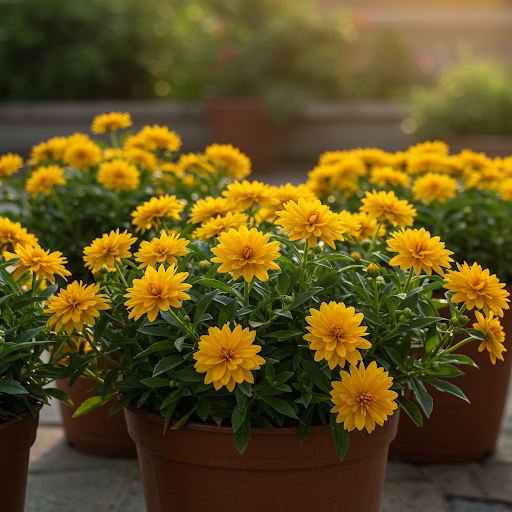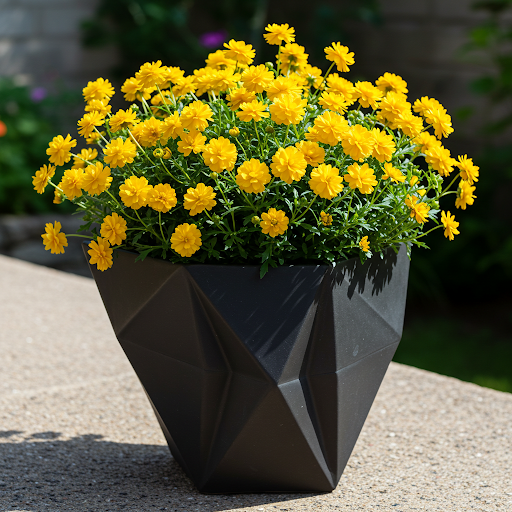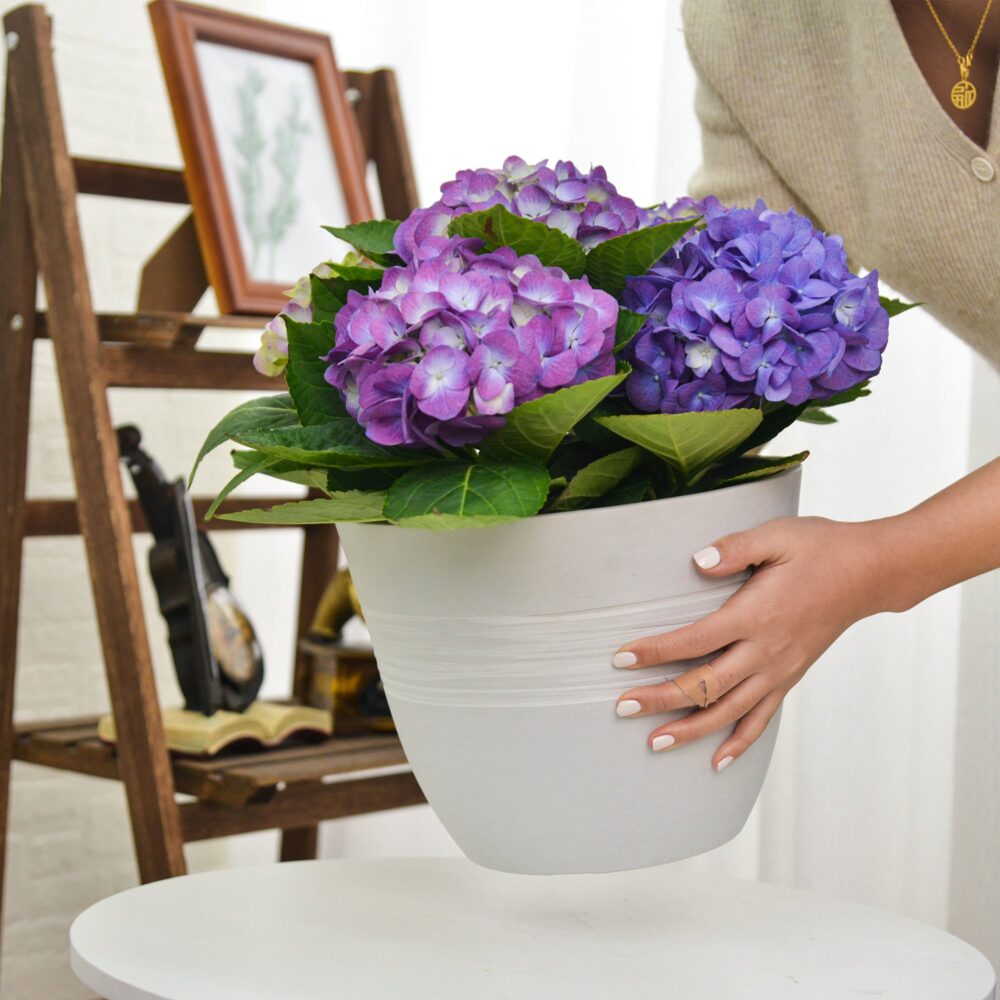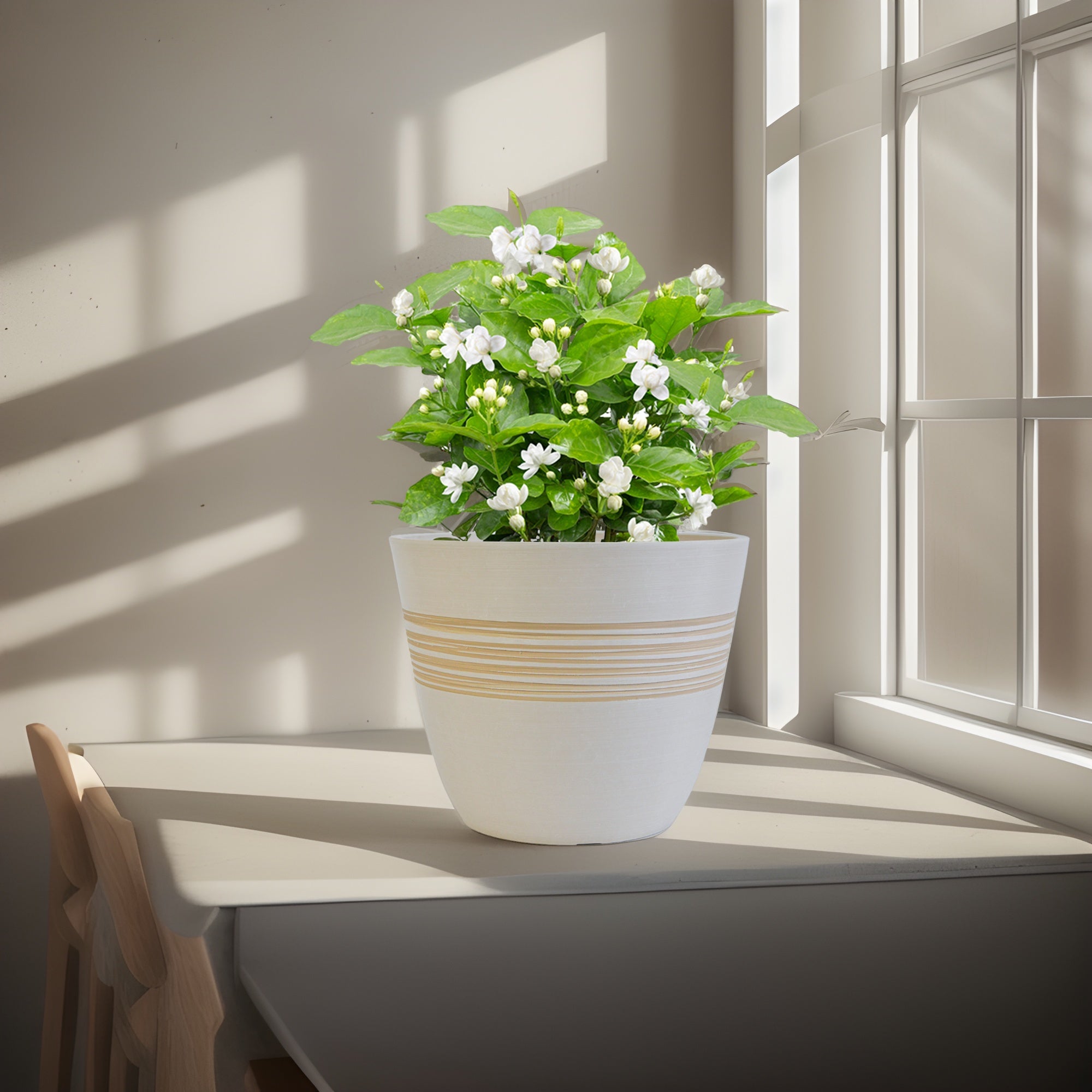Melampodium in Pots: The Ultimate Guide to Growing Blackfoot Daisies Outdoors in Containers
Want to fill your sunny patio, balcony, or garden with cheerful, daisy-like blooms and carefree charm? Melampodium, commonly known as Blackfoot Daisy or Butter Daisy, are wonderfully easy and rewarding choices for outdoor container gardening.1 Celebrated for their profusion of small, bright yellow, daisy-like flowers, their long blooming season from spring to fall, their drought and heat tolerance, and their low-maintenance nature, Melampodium are perfect for adding sunshine and effortless beauty to sunny outdoor spaces. This comprehensive guide will provide you with everything you need to know to grow Melampodium successfully in outdoor pots, from selecting the best varieties and containers to mastering essential care techniques for a season filled with Blackfoot Daisy blooms and sunny disposition.

Melampodium
What are Melampodium (Blackfoot Daisies)?
Melampodium, commonly called Blackfoot Daisy or Butter Daisy, is a genus of flowering plants in the Asteraceae family (daisy family).2 Native to North and Central America, Melampodium are popular annuals and perennials(depending on the species and climate) grown for their abundant, small, daisy-like yellow flowers and easy-care nature. Melampodium flowers are famous for their prolific, cheerful blooms that resemble miniature yellow daisies.3They come in shades of bright yellow to golden yellow, with a prominent dark brown or black central cone, giving them the common name “Blackfoot Daisy”.4 Melampodium plants are characterized by their bushy, spreading growth habit, small, dark green leaves, and generally compact size.5 They exhibit a mounding to spreading growth habit, ranging in height from under 1 foot to about 2 feet tall, depending on the species and cultivar. They are known for their prolific blooming, bright yellow daisy flowers, long blooming season (spring to fall), sun-loving nature, and exceptional drought and heat tolerance, making them an invaluable addition to gardens and containers, especially for adding low-maintenance, long-lasting sunshine and pollinator appeal.
Are Melampodium Good for Outdoor Pots?
Yes, Melampodium are exceptionally well-suited for outdoor pots and container gardening, especially dwarf and compact varieties.6 Their bushy, spreading growth habit, exceptionally long blooming season, tolerance of sunny locations, heat, and drought, and cheerful, low-maintenance flowers make them ideal for filling pots, patio containers, window boxes, and mixed container arrangements for sunny locations.7 Melampodium thrive in full sun and bloom profusely from spring until frost, providing an incredibly long-lasting and delightful display in containers.8 Their very easy-care nature and masses of blooms make them a fantastic and rewarding choice for container gardens of all styles, especially for adding a naturalistic, drought-tolerant, or pollinator-friendly touch to patios, balconies, and decks. Growing Melampodium in pots also allows you to easily move them to optimal locations to enjoy their beauty, to follow the sun, and to control their growing conditions, especially soil drainage which they appreciate.
Ideal Growing Conditions for Melampodium in Pots:
Types of Melampodium for Pots: Several Melampodium species and cultivars are excellent for pots, but consider your desired size and growth habit when choosing:
- Melampodium divaricatum (Butter Daisy, Gold Medallion): This is the most commonly cultivated species, known for its vigorous growth, profuse yellow blooms, and heat and drought tolerance. Excellent for pots, especially larger containers. Look for compact cultivars like ‘Million Gold’, ‘Showstar’, ‘Medalion’, and ‘Derby’. These are typically grown as annuals.
- Melampodium leucanthum (Blackfoot Daisy): A native perennial in the southwestern US, known for its smaller, daintier white daisy flowers with a black center, and fine-textured foliage. More drought-tolerant and lower-growing than M. divaricatum. Suitable for smaller pots and rock gardens in containers. Look for selections of the species, or named cultivars are less common. Can be perennial in warmer zones (USDA 5-9), or annual in colder areas.
- Compact Melampodium Cultivars: For container gardening, especially smaller pots, choose compact cultivars of M. divaricatum like ‘Million Gold’, ‘Showstar’, ‘Medalion’, ‘Derby’, ‘Jackpot Gold’, ‘Lemon Delight’, and ‘Pedro’.9 These stay more contained and are well-suited to pot culture.
- Trailing Melampodium (for hanging baskets/window boxes): While Melampodium are not typically strongly trailing, some M. divaricatum cultivars can have a slightly spreading habit that works well in larger window boxes or spilling over the edges of pots. Look for descriptions mentioning “spreading” or “mounding-spreading” growth habits.
Light: Melampodium thrive in full sun.10 They need at least 6-8 hours of direct sunlight per day to bloom profusely and develop their best, most vibrant flower color and compact growth. Choose a sunny location for your Melampodium containers, such as a south-facing patio, balcony, or garden bed. In partial shade, Melampodiumwill produce fewer blooms, become leggy, and their flower production will be reduced. Full sun is essential for optimal flowering, compact growth, and best drought tolerance.11
Soil: Melampodium need well-draining soil and are not particularly fussy about soil fertility.12 They tolerate a range of soil types, but good drainage is crucial to prevent root rot, especially in pots.13 Use a high-quality potting mixspecifically formulated for containers or flowers. Amend potting mix with perlite, vermiculite, or horticultural gritto improve drainage and aeration, especially if using heavier potting mixes. While they appreciate consistent moisture when young, established Melampodium are quite drought-tolerant and prefer soil that is not constantly soggy.14 Avoid heavy, compacted soil or garden soil in pots, as they can become waterlogged. A slightly acidic to neutral pH (around 6.0-7.5) is suitable for Melampodium.15
Watering: Melampodium are exceptionally drought-tolerant once established, making them ideal for low-water container gardens.16 However, they will bloom best with moderate watering, especially when young and during active growth and blooming periods. Water thoroughly when the top inch or two of soil feels dry. Water deeply until water drains out of the drainage holes. Allow the soil to dry out somewhat between waterings. Avoid overwatering and constantly soggy soil, which can lead to root rot, especially in pots. Melampodium are much more tolerant of under-watering than overwatering. Watering frequency will depend on weather conditions, light levels, pot size, and plant size. During hot summer months, you may need to water more frequently, especially for smaller pots in full sun or windy locations, but still allow soil to dry slightly between waterings. Check soil moisture regularly and adjust watering accordingly. Reduce watering slightly in late summer as temperatures cool and plants begin to set seed and naturally slow down blooming. Water at the base of the plant to avoid wetting foliage and flower heads, which can help prevent potential fungal issues, though Melampodium are generally quite disease-resistant.
Temperature: Melampodium are warm-weather plants that thrive in warm to hot temperatures.17 They perform best in temperatures between 70°F to 90°F (21°C to 32°C). They are very heat-tolerant and flourish in hot summer conditions.18 Melampodium are frost-tender and are not cold-hardy annuals (M. divaricatum). Melampodium leucanthum (Blackfoot Daisy) is perennial in USDA zones 5-9, tolerating colder temperatures, but still benefits from warm summer conditions. In most climates, Melampodium are grown as annuals, planted out in spring after the last frost.19 Potted Melampodium are easy to move to optimal locations to enjoy their beauty and follow the sun. They do not tolerate frost or freezing temperatures.
Fertilizer: Melampodium are light feeders and do not require rich soil or heavy fertilization. Over-fertilizing can lead to excessive leafy growth and fewer blooms, and weaker stems. Fertilize sparingly, if at all. In most cases, Melampodium grown in good quality potting mix will not need any supplemental fertilization. If desired, you can fertilize once or twice mid-season at most with a balanced liquid fertilizer (e.g., 10-10-10 or 20-20-20) diluted to half strength, or use a very low rate of slow-release granular fertilizer incorporated into the potting mix at planting time. Avoid high-nitrogen fertilizers, which can promote leafy growth at the expense of blooms. Too much fertilizer can actually reduce flowering and overall plant vigor in Melampodium. They thrive in slightly leaner soil conditions.
Choosing the Right Pots for Melampodium:
Suitable Pot Types: Melampodium are adaptable to various pot types, including terracotta, ceramic, plastic, resin, and even more rustic or porous containers. Consider these factors when selecting pot types for Melampodium:
- Terracotta Pots: Porous, allow excellent aeration and drainage, and aesthetically classic and warm-toned, complementing Melampodium‘s sunny yellow blooms and natural charm.20 Terracotta is an excellent choice for Melampodium as it provides superb drainage and helps prevent overwatering, which is crucial for these drought-tolerant plants. Terracotta pots also dry out more quickly, which is generally beneficial for Melampodium, helping to avoid soggy soil.21 Monitor soil moisture and water as needed, especially in very hot and dry conditions.
- Unglazed Ceramic Pots: Similar to terracotta, unglazed ceramic pots offer good aeration and drainage. Choose unglazed ceramic over glazed for better breathability and drainage.
- Plastic Pots: Lightweight, inexpensive, retain moisture well, and are available in various colors and styles. A good choice for Melampodium, especially for larger pots that need to be moved. Choose good quality plastic pots with drainage holes. Lighter colored plastic pots may heat up less in direct sun. Be mindful of not overwatering in plastic pots, as they retain moisture more than terracotta.
- Resin Pots: Lightweight, durable, available in various styles mimicking terracotta or ceramic, and offer a balance of drainage and moisture retention.22 A good alternative to heavy ceramic pots, and often more durable than terracotta or plastic. Resin pots can work well, but ensure good drainage and avoid overwatering, especially in heavier resin types.
- Porous Containers: More porous containers like hypertufa, concrete (unsealed), or even unglazed ceramic strawberry jars can be excellent choices for Melampodium, providing excellent drainage and aeration, mimicking their preference for slightly drier, well-drained conditions.
- Window Boxes & Long Planters: Compact Melampodium varieties look beautiful massed in window boxes and long planters, creating a cheerful and sunny display.23 Ensure good drainage and adequate spacing between plants.
Drainage: Excellent drainage is absolutely essential for Melampodium to prevent root rot. They are highly susceptible to root rot in soggy conditions. Ensure your chosen pot has drainage holes at the bottom. Avoid pots without drainage holes. Adding a generous layer of gravel or pot shards at the base of the pot is highly recommended to further improve drainage, especially in heavier pots or if you tend to overwater. Elevating pots slightly on pot feet or bricks can further improve drainage and air circulation around the base.24
Pot Size: Choose pot sizes appropriate for the type and mature size of the Melampodium you are planting, and the desired visual impact. Melampodium have moderately sized root systems and need adequate space for healthy growth and flowering.
- Dwarf/Compact Melampodium: For dwarf or compact Melampodium cultivars, pots that are 6-10 inches in diameter and at least 6-8 inches deep are suitable for individual plants. For mass plantings or window boxes, use larger containers or window boxes with spacing of about 8-12 inches between plants.
- Larger Melampodium (e.g., M. divaricatum species): For larger, more vigorous Melampodium divaricatumspecies, use pots that are 10-14 inches in diameter or larger and at least 8-10 inches deep for individual plants, or larger patio containers for multiple plants or mixed arrangements. Larger varieties need more root space and stability.
Color and Style: Choose pot colors and styles that complement your Melampodium blooms and your outdoor décor, and enhance their sunny, natural charm. Earthy tones, terracotta, aged wood, or natural stone-look pots can enhance the wildflower-like beauty of Melampodium. Brightly colored pots in yellows, oranges, blues, or greens can create a vibrant, cheerful display. Rustic or simple, unadorned pot styles enhance the low-maintenance, natural appeal of Melampodium. Consider the overall style of your patio or garden and choose pots that harmonize with the surroundings, and enhance the sunny, carefree ambiance you wish to create.
Essential Care Tips for Thriving Melampodium in Outdoor Pots:
- Watering: “Water Sparingly, Allow Soil to Dry Between Waterings, Excellent Drainage is Key”. Water thoroughly only when the top inch or two of soil is dry. Water deeply and then allow the soil to dry out somewhat between waterings. Avoid overwatering and soggy soil at all costs. Excellent drainage is crucial. Melampodium are very drought-tolerant once established and prefer drier conditions to constantly wet soil.25
- Sunlight: Provide Full Sun (6-8+ Hours Daily). Place Melampodium pots in a location that receives full sun for optimal growth, blooming, and compact habit.26
- Fertilizing: Fertilize Very Sparingly, or Not at All. Avoid Over-Fertilizing. Fertilize very sparingly, if at all. In most cases, fertilization is not needed in good potting mix. If desired, fertilize very lightly only once or twice mid-season with a dilute balanced fertilizer. Avoid over-fertilizing.
- Deadheading (Encourage Continuous Bloom & Tidiness): Deadheading spent flower heads is recommended to encourage continuous blooming and maintain a tidy appearance, although Melampodium are somewhat self-cleaning. Snip off faded flowers to encourage more buds. Regular deadheading promotes more prolific flowering throughout the season.
- Pinching (Encourage Bushier Growth, Optional): Pinching back young Melampodium seedlings when they are young can encourage bushier growth and more flower stems, although they are naturally quite bushy.27 Pinch off the tips of stems when plants are young to promote branching if desired. Pinching is optional, but can result in fuller, bushier plants with even more blooms.
- Drought Tolerance: Exceptionally Drought-Tolerant Once Established. Melampodium are highly drought-tolerant once established and can withstand periods of very dry soil, making them ideal for low-water container gardens and hot, dry climates.28 Avoid overwatering and soggy soil, which is a greater risk than underwatering.
- Pest and Disease Control: Melampodium are generally exceptionally pest and disease-resistant, making them very low-maintenance in this regard.29 Pests and diseases are rarely a significant issue for Melampodium.30 Good air circulation and well-draining soil further help prevent any potential fungal issues.
Popular Melampodium Cultivars for Pots (by Type/Size/Color):
- Melampodium divaricatum Cultivars (Butter Daisy):
- ‘Million Gold’: (Compact, dwarf, very floriferous, bright gold blooms, classic Butter Daisy).31 Excellent for pots, window boxes.
- ‘Showstar’: (Compact, mounding, large golden yellow blooms, vigorous).32 Good for pots, mixed containers.
- ‘Medalion’: (Compact, mounding, golden yellow blooms, early flowering). Well-suited to pots, reliable bloomer.
- ‘Derby’: (Compact, mounding, bright yellow blooms, uniform habit). Good for mass plantings in pots, edging.
- ‘Jackpot Gold’: (Slightly larger, vigorous, golden yellow blooms, abundant flowers).33 Suitable for larger pots, patio containers.
- ‘Lemon Delight’: (Compact, lemon-yellow blooms, softer color).34 Nice for pastel color schemes in pots.
- ‘Pedro’: (Dwarf, very compact, golden yellow blooms, tight habit). Ideal for small pots, rock gardens in containers.
- Melampodium leucanthum (Blackfoot Daisy) Selections:
- Species Selections: (Typically white daisies with black centers, fine foliage, lower growing, more drought-tolerant). Best for smaller pots, rock gardens, naturalistic containers. Look for species seed or plants. Cultivars are less common.
In Summary:
Growing Melampodium (Blackfoot Daisies) in outdoor pots is a wonderfully rewarding way to fill your sunny patios, balconies, and gardens with cheerful, daisy-like blooms and effortless charm from spring to fall. Their prolific flowering, bright yellow color, exceptional drought and heat tolerance, and very easy, low-maintenance nature make them a perfect choice for container gardeners seeking low-water, sun-loving, and enduringly cheerful plants. By providing full sun, very well-draining potting mix in pots with excellent drainage, watering sparingly and allowing soil to dry between waterings, fertilizing very little (or not at all), deadheading spent flowers, and choosing pot sizes and styles that complement their sunny disposition, you can easily cultivate thriving Melampodium plants in pots and enjoy their captivating, carefree beauty and pollinator-attracting blooms from spring planting until frost, year after year as annuals (or perennials in suitable zones).

Melampodium
For more detailed botanical information and to explore the diverse world of Melampodium, you can visit the Wikipedia page on Melampodium.
Important Note: Melampodium plants are generally considered non-toxic to humans and pets, making them a safe and attractive choice for households with children and animals.35 The primary care benefits of Melampodium in pots are their exceptionally long blooming season, cheerful and abundant daisy-like flowers, bright yellow color, exceptional drought and heat tolerance, and very easy, low-maintenance care, bringing enduring sunshine and carefree beauty to your outdoor spaces for many months. With these simple care practices, you can enjoy a season filled with the delightful charm of Melampodium in your outdoor containers.
KC2-21G
By greenship|2024-08-13T06:19:08+00:00August 13, 2024|Categories: Hand-carving Series|
11TH
By greenship|2024-08-13T02:50:25+00:00August 13, 2024|Categories: Hand-carving Series|
KC2-11V
By greenship|2024-08-16T05:39:50+00:00August 16, 2024|Categories: Hand-carving Series|
20VD
By greenship|2024-08-13T06:43:41+00:00August 13, 2024|Categories: Hand-carving Series|
Planter for Indoor Outdoor Plants, Set of 2 Modern Decorative Plant Pots with Drainage Hole, Decorative Flower Pots
By greenship-seo|2025-01-14T12:26:44+00:00January 14, 2025|Categories: Hand-carving Series|Tags: Decorative Flower Pots|
Planter for Indoor Outdoor Plants, Set of 2 Modern Decorative Plant Pots with Drainage Hole, Decorative Flower Pots
By greenship-seo|2025-04-10T07:46:01+00:00January 9, 2025|Categories: Hand-carving Series|Tags: Decorative Flower Pots, Self-Watering Pots|






